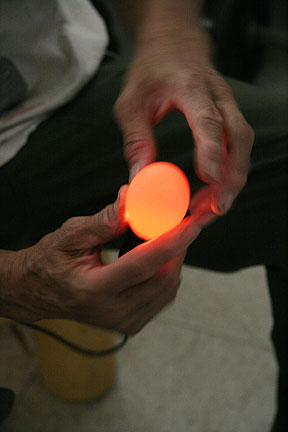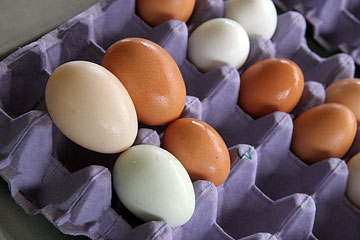EGGSTINCTION?
 CRAIG T. KOJIMA / CKOJIMA@STARBULLETIN.COM
Greg Yee "candles" his eggs for disease and for fertilized eggs. Yee has a North Shore property where he raises his free-range chickens and eggs. CLICK FOR LARGE |
|
Egg farmers knocked from their roost
Hawaii egg farmers are being pushed out of business by high shipping costs, stricter regulations and mainland competition
STORY SUMMARY »
WHEREAS local egg farms once supplied most of the eggs consumed in Hawaii, they are now losing the market share to mainland suppliers.
The high cost of shipping feed to Hawaii, in addition to stricter regulations and mainland competition, have pushed a lot of local egg farmers out of the business.
Only a handful of commercial egg farms -- four on Oahu and one on the Big Island -- continue to survive. Maui Fresh Eggs closed earlier this year in March due to the higher costs of safety grading as well as the cost of feed.
Most of the farms that remain, like the Mikilua Poultry Farm on the leeward side and Peterson's Upland Farm in Wahiawa, are family-run businesses that have been around for generations.
Some farmers, like Greg Yee of Blue Lotus farm, have found a niche by producing locally grown free-range eggs raised on the North Shore. But Yee produces too small a quantity to be counted by the state, and he, too, faces competition from the mainland.
Consumers must be willing to pay a higher price for local eggs, according to advocates, if the local farms are to survive. At the same time, they will be getting fresher eggs.
FULL STORY »
EGGS BENEDICT, omelets, and loco moco soon may be made entirely from eggs flown in from out of state.
Today, just a little more than a third of the eggs sold in the state are locally produced, according to the state Department of Agriculture. Much like the situation with milk, there soon may be little to no eggs produced in Hawaii.
Whereas there were once 1 million chickens laying more than 200 million eggs a year some 25 years ago, those numbers have quickly dwindled down to just a little more than 440,000 last year, with a paltry production of 96.9 million eggs.
The outlook this year doesn't look too bright, either. Up to April, the state counted just 380,000 chickens laying 27.3 million eggs, according to the Hawaii Agricultural Statistics Service.
But don't blame it on the chickens.
It's not because they're sitting around lazing in the sun -- it's because fewer farmers are managing to survive in the face of mainland competition, and that results in fewer commercial egg-laying chickens.
Whereas in 1999, there were 11, there are now only four commercial egg farms left on Oahu -- and one left on the Big Island.
"The cost of feed has skyrocketed within the past year," said Beth Asagi, president of the Hawaii Egg Producers Association. "Just the cost of shipping alone is what's killing everybody."
Asagi estimated the cost of feed and freight was triple what it used to be just a few years ago. She said all of the farms have cut down their production, and are just managing to survive.
With the closure in March of Maui Fresh Eggs, none are left on the Valley Isle or Kauai.
The only farms left on Oahu are the Mikilua Poultry Farm, which supplies the brand, Ka Lei Eggs; Peterson's Upland Farm in Wahiawa; KK Poultry in Waimanalo; and Maili Moa, a small farm in Waianae.
Along with mainland competition, the demand for stricter compliance with state and federal food safety regulations also are jacking up the costs of doing business.
Expensive to feed
Hawaiian Fresh Egg Farm, run by David M. Davenport, remains the lone supplier on the Big Island.
Davenport, who's been in the business almost 21 years, says the higher costs of feed freight have taken their toll.
With close to 40,000 egg-laying chickens, he says he's "just a drop in the bucket" compared to mainland farms which have more than 1 million chickens.
He sells his eggs only on the Big Island, and is fortunate to be carried at KTA Super Stores, but doesn't know if that's enough to keep the business viable. Business has dropped about 20 percent over the last two to three years.
"We're all very dependent on shipping," he said.
Davenport is also one of the few farmers that sell straight from his farm.
Since Hawaii does not have a feed mill, local farmers must purchase finished feed at a higher cost, along with the soaring cost of its transport to the islands.
The mainland advantage
Mainland eggs have the competitive advantage in this market -- farmers there can produce eggs cheaper and then ship and sell them for less in Hawaii's supermarkets.
Local farmers say the state Legislature's approval of a $3 million feed subsidy over the next two years is nice, but it's coming a little too late.
And without the chickens, there would be no eggs.
The loss of many of Hawaii's egg farms and businesses also means a loss of longtime family operations, some of which have been around for several generations.
The Associated Producers Corp., run by sisters Phyllis and Lois Shimabukuro, is a third-generation business, selling country fresh Ka Lei Eggs as well as running a retail store in Kaimuki. The family has been producing eggs from its family farm in Mikilua valley since 1947.
 CRAIG T. KOJIMA / CKOJIMA@STARBULLETIN.COM
In top left, some eggs from Greg Yee's farm, including four different types grouped together in a square. They are a duck egg, top left, Arucana egg, bottom left, a large egg from a mature chicken, top right, and a smaller young chicken's egg, bottom right. CLICK FOR LARGE |
|
Peterson's Upland Farm, for instance, has been around since 1910, serving the Wahiawa community.
Nelson Okumura blames mainland competition and demand for U.S. Department of Agriculture certification for putting Maui Fresh Eggs -- Maui's last egg farm -- out of business in March.
Okumura said his farm, with its 50,000 chickens, just didn't have the same economies of scale as mainland farms. So when clients like Costco Wholesale Corp. began asking for the U.S. Department of Agriculture grading, the extra costs for a federal inspection just didn't balance out the profits.
"For a small-scale farm, you don't have the volume to spread those costs," said Okumura.
And without Costco as a client, Okumura said the farm lost a third of its business.
On top of that, Okumura said in its last months of operation, the company was paying as much as $320 per ton for feed, including the freight. He also had a hard time finding adequate help for the farm, which offered only minimum wage pay.
Given a government subsidy and another opportunity, Okumura said he's not likely to return to the egg farm business.
"I just don't see being able to turn it around," he said.
Organic niche?
There may be some hope for small farmers in niche markets, with the public's growing interest in organic, free-range eggs. But farmers in that niche also face mainland competition.
Greg Yee of Blue Lotus farm started out as an organic farmer seven years ago, eventually offering eggs, and then free-range chickens from his one-acre farm on the North Shore.
Now he's a regular at the Saturday Farmer's Market at Kapiolani Community College. Being a one-man operation, Yee hasn't focused so much on expanding although his eggs -- about 500 a week -- sell out quickly for $5 a dozen.
He even has high-end clients like the Hakone Restaurant at the Waikiki Prince Hotel.
So far, he's captured a corner of the market by hand-feeding his Rhode Island Reds a formula of special alkalized water and feed, along with grass and whole-grain bread, and letting them wander outside the coop.
But mainland suppliers are also selling organic eggs -- which are USDA-certified and claim to come from chickens that are fed pesticide-free grains, and free to roam as well as rest in the shade.
Yee wouldn't be counted as a commercial egg farm by the state, which only tracks those with 3,000 or more laying birds.
Some fear that if there is no turnaround, there soon will be no local eggs produced in these islands.
While some discerning customers might prefer a local egg, thinking it's fresher, the average shopper at the supermarket will more than likely go for the eggs at a lower price rather than pay another dollar or more for a dozen locally grown eggs.
At Safeway, a dozen locally grown Ka Lei Eggs costs $4.39, whereas Lucerne eggs cost $3.09 a dozen at the Safeway Club Price. A dozen organic eggs from the mainland costs $3.99.
Chefs like Alan Wong are trying to turn the tide.
As a kid, he used to accompany his parents up to Peterson's Farm to buy eggs by the flat. As a chef, he now buys Peterson's Farm eggs to supply his restaurants.
For Wong, it's as much about global sustainability as supporting local business from the community where he grew up.
"With the big boxes and chains coming to town, we've got to support the mom and pop stores in Hawaii," Wong said. "You're talking about a farm that has existed for several generations. When you go to the farm and meet the Petersons, they're hard working and dedicated to what they do and they're humble. These small businesses make up the fabric of the community of Wahiawa."

